|
|
|
If under cruise conditions with the FireFly trimmed out in roll and pitch, and if the ball does not remain centered, uncompensated P-Factor is at work. I had a lot of trouble understanding this concept.
I believe the way it (P-Factor) works is:
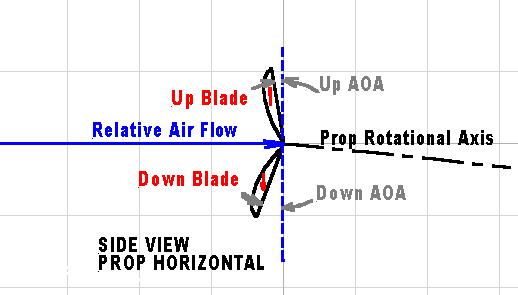 In the three point stance or with the flight path level and flying nose high, the down blade has more angle of attack (aoa) than the up swinging blade. (One can verify this by turning the propeller horizontal, and taking an incline meter reading from each blade.) In the three point stance or with the flight path level and flying nose high, the down blade has more angle of attack (aoa) than the up swinging blade. (One can verify this by turning the propeller horizontal, and taking an incline meter reading from each blade.)
This means that the down swinging blade generates more thrust than the up swinging blade, which moves the propeller center of thrust toward the down propeller blade swinging side of the aircraft. This creates a twisting moment in the horizontal plane so that one must apply opposite side rudder pedal pressure to keep the aircraft from skidding and to center the ball. If this is the case, one can raise the rear or lower the front of the engine mount by adding or removing washers to reduce the aoa of the down swinging blade and to increase the aoa of the up swinging blade.
If one has to hold same side rudder pedal pressure as the down swinging blade, washer in the opposite direction. Basically one is moving the propeller thrust vector to coincide with propeller shaft rotational axis and parallel to the cruise air flow direction. By doing so, one does not have to add a trim tab to the rudder. Also, when the ball is centered at cruise, the FireFly is flying in its lowest yaw drag configuration.
Another way to look at it is, if at cruise, one has to push the ball back in with the same rudder pedal as required to hold the FireFly straight for takeoff, then raise the back or lower the front of the engine. If at cruise, one has to push the ball back in with opposite rudder pedal used to hold the FireFly straight for takeoff, then raise the front or lower the back of the engine. In the case of my FireFly, one washer width moves the ball about one-fourth the ball diameter. It takes just a few minutes to change washers, and by doing so your FireFly will be much easier and more efficient to fly at cruise. And one does not have to add a trim tab to the rudder.
The beauty of this approach is that one does not need to worry about Lord mount flexure or anything else except where the ball is at cruise with no pressure on the rudder pedals during horizontal flight. If for some reason, one does not want to raise or lower the engine, one can make a new engine mount and move the engine toward the down turning blade side. This will counter the twisting moment described above.
|
Update - 11/11/2003
On the FireFly, I could washer out all but about one-half of a ball out. Adding additional washers did not move the ball any closer to center. So I thought I would have to slide the engine over or to add a rudder trim tab. Pressing on the right rudder pedal to bring the ball into center at cruise required quite a bit of pressure. I really did not want to add additional weight by installing a rudder tab, and I did not want to go through the agony of trying to slide the whole engine side ways. It was just too much work, and so I have flown the FireFly for about 40 hours with the ball about one-half ball out. Then, it struck me that I do not have to move the engine, just the propeller. The belt reduction unit is held in place with a symmetrical and equally spaced eight bolt pattern. So one can rotate the unit in 45 degree increments.
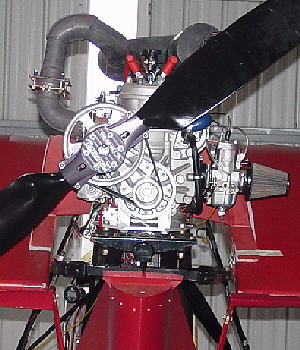 It looks strange, but it works. I was able to move the propeller to the left by rotating the belt reduction bracket by 45 degrees or one bolt hole. This moves the thrust line down one inch and to the left about 4 inches. With this change the FireFly cruises with the ball almost perfectly centered. It is quieter than before so some drag has been removed, it is cruising faster than before, right rudder pressure is reduced on takeoff and climb out, and no weight was added. It looks strange, but it works. I was able to move the propeller to the left by rotating the belt reduction bracket by 45 degrees or one bolt hole. This moves the thrust line down one inch and to the left about 4 inches. With this change the FireFly cruises with the ball almost perfectly centered. It is quieter than before so some drag has been removed, it is cruising faster than before, right rudder pressure is reduced on takeoff and climb out, and no weight was added.
I would like to try the next rotation because it would move the propeller another inch to the left and drop the thrust line another four inches. But it is doubtful that the Powerfin propeller tips will clear the tail boom tube. It would be interesting to remount the smaller diameter IVO to see how the FireFly will respond to a much lower thrust line.
|
Update - 01/15/2004
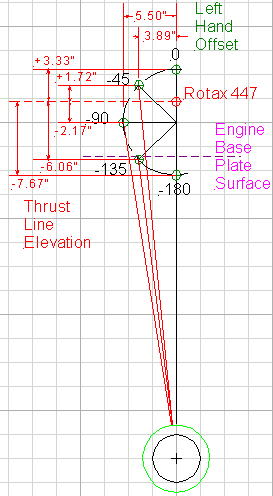 The weather has not been favorable for flying or working on the FireFly. I became curious at the differences in the thrust line and offset possibilities by rotating the belt reduction unit on the Victor 1+. And so, I took some measurements and sketched it up so that I could find the maximum propeller sizes and offsets for each rotation of the belt reduction unit.
The weather has not been favorable for flying or working on the FireFly. I became curious at the differences in the thrust line and offset possibilities by rotating the belt reduction unit on the Victor 1+. And so, I took some measurements and sketched it up so that I could find the maximum propeller sizes and offsets for each rotation of the belt reduction unit.
The lower dashed line represents the top of the engine mounting plate. The red upper dashed line passes through the thrust line of the Rotax 447 gear box. The numbers on top represent the thrust line offset as the reduction unit is rotated to the left. The numbers to the left represent vertical thrust line deviation from the Rotax 447 location.
The black circle on the bottom represents the tail tube, and the green circle indicates a one inch propeller tip clearance ring. The largest propellers that can be swung are:
Deg - Prop Dia
0 - 74
45 - 71
90 - 64
135 - 56
180 - 52
|
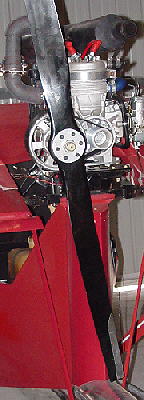 The largest propeller that could be swung by the Rotax 447 was 67 inches.
The largest propeller that could be swung by the Rotax 447 was 67 inches.
The FireFly flew well with a 60 inch two blade propeller on the Rotax 447. I am interested in how the FireFly will perform with the propeller set at the 45, 90 and 135 degree positions. To check this out I have remounted the IVO propeller as it will clear the tail tube at the 90 degree position.
In this configuration, a flight test showed the ball centered at cruise and only light rudder pressure was required to make coordinated turns in either direction. In flight cruise noise seemed to be less.
On the second test flight I wanted to check out cruise speed with my gps, but it would not power up, so I flew around the airport and made one touch and go and then landed and taxied back to the hangar. When I computed the average fuel flow, it came out to 1.83 gph. This is outstanding in that the total air time was 16 minutes 25 seconds. The fuel level was read before start and engine warm-up on a 40 degree day. On taxi out I had to wait for a jet to back taxi and clear the runway and so I had an extended wait for runway access. I would have expected for this short a flight time for the average fuel flow rate to come out to over two gph. So getting rid of the skidding or improving yaw trim is letting the FireFly slip through the air a little better.
|
Update - 06/15/2004
I have been flying the FireFly with an IVO 56 inch propeller set at the 135 degree position as shown in the diagram above. Today I made two flights without changing propeller pitch. The first flight was with the reduction unit set at the 135 degree position and the second with the reduction unit set at the 45 degree position. This kept the same propeller left offset but raises the propeller 7.78 inches.
Conditions for both flights were about the same. Engine rpm was 5,200 rpm, altitude was 1,500 feet asl, elevator was held at the neutral position, and data was the average of gps speeds taken on up and down wind runs. There was about an hour in-between the flights and I did not top off the tank in-between flights so the last flight was about six pounds lighter than the first. The cruise speed for first flight was 54 mph and for the second it was 49.5 mph. For every inch I raised the thrust line, I lost 0.58 mph.
|
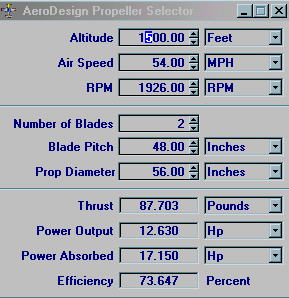 I put the first data into some software that I found on the internet. It lets one compute a thrust and hp for a given set of conditions. The rpm is 5,200 divided by 2.7, the belt reduction ratio. The propeller pitch was measured at the tip and found to be 15.25 degrees. The blade pitch was found by pi x 56 x tangent of 15.25 degrees.
I put the first data into some software that I found on the internet. It lets one compute a thrust and hp for a given set of conditions. The rpm is 5,200 divided by 2.7, the belt reduction ratio. The propeller pitch was measured at the tip and found to be 15.25 degrees. The blade pitch was found by pi x 56 x tangent of 15.25 degrees.
The software computes the propeller thrust, hp output and input, and efficiency. Since this is an equilibrium condition, one can assume that the thrust equals the FireFly's drag at this speed.
Note: the bottom portion of the display has been removed to save space.
|
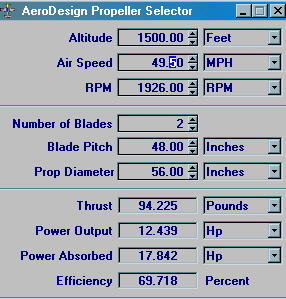 This is the same as above, except the true air speed was found to be 49.5 mph. The thrust is about seven pounds greater due to increased drag and this caused a speed loss while the engine is putting out about the same hp and propeller efficiency drops.
This is the same as above, except the true air speed was found to be 49.5 mph. The thrust is about seven pounds greater due to increased drag and this caused a speed loss while the engine is putting out about the same hp and propeller efficiency drops.
The data base for the software was taken from a family of propellers that were tested in a wind tunnel, so there was little profile interference with the airflow to and through the propellers. In the case of the FireFly, the engine greatly masks the propeller and as the thrust line is lowered, the propeller moves more and more into clean air below the wing.
Fuel consumption rates at 5,200 rpm will not change by a significant amount but a 4.5 mph speed change is significant. With the lower thrust line, the tail surfaces and the wing are experiencing lighter loads and the FireFly slips through the air a little easier. Now I have to get the courage to cut the propeller to 52 inches to see if lowering the thrust line another 1.6 inches will pick up another mph.
If you would like to down load the free software used above, it can be found at:
http://www.geistware.com/rcmodeling/articles/propeller_selector.htm
When the file is unzipped, there will be two executable files, "Prop sel.exe" and "Extend.exe". The "Extend.exe" was the software used to obtain the displays shown above.
2/27/15
geistware.com has departed from the web. The software is still available from rcmodel web sites.
|
|
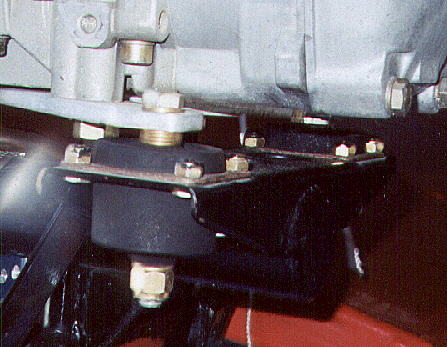 No washers are used under the front engine mounts. Washers have been added under the rear engine mounts to adjust the engine thrust angle to correspond to the desired cruise speed.
No washers are used under the front engine mounts. Washers have been added under the rear engine mounts to adjust the engine thrust angle to correspond to the desired cruise speed.
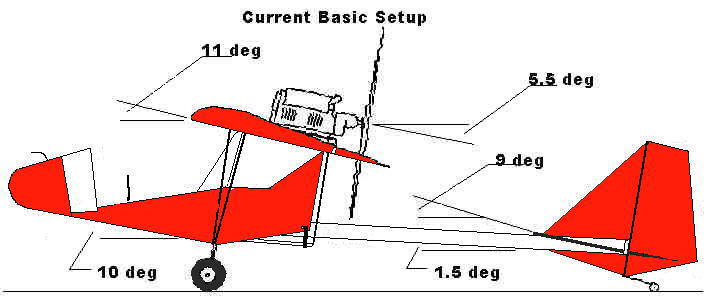
 In the three point stance or with the flight path level and flying nose high, the down blade has more angle of attack (aoa) than the up swinging blade. (One can verify this by turning the propeller horizontal, and taking an incline meter reading from each blade.)
In the three point stance or with the flight path level and flying nose high, the down blade has more angle of attack (aoa) than the up swinging blade. (One can verify this by turning the propeller horizontal, and taking an incline meter reading from each blade.)
 It looks strange, but it works. I was able to move the propeller to the left by rotating the belt reduction bracket by 45 degrees or one bolt hole. This moves the thrust line down one inch and to the left about 4 inches. With this change the FireFly cruises with the ball almost perfectly centered. It is quieter than before so some drag has been removed, it is cruising faster than before, right rudder pressure is reduced on takeoff and climb out, and no weight was added.
It looks strange, but it works. I was able to move the propeller to the left by rotating the belt reduction bracket by 45 degrees or one bolt hole. This moves the thrust line down one inch and to the left about 4 inches. With this change the FireFly cruises with the ball almost perfectly centered. It is quieter than before so some drag has been removed, it is cruising faster than before, right rudder pressure is reduced on takeoff and climb out, and no weight was added.
 The weather has not been favorable for flying or working on the FireFly. I became curious at the differences in the thrust line and offset possibilities by rotating the belt reduction unit on the Victor 1+. And so, I took some measurements and sketched it up so that I could find the maximum propeller sizes and offsets for each rotation of the belt reduction unit.
The weather has not been favorable for flying or working on the FireFly. I became curious at the differences in the thrust line and offset possibilities by rotating the belt reduction unit on the Victor 1+. And so, I took some measurements and sketched it up so that I could find the maximum propeller sizes and offsets for each rotation of the belt reduction unit.
 The largest propeller that could be swung by the Rotax 447 was 67 inches.
The largest propeller that could be swung by the Rotax 447 was 67 inches.
 I put the first data into some software that I found on the internet. It lets one compute a thrust and hp for a given set of conditions. The rpm is 5,200 divided by 2.7, the belt reduction ratio. The propeller pitch was measured at the tip and found to be 15.25 degrees. The blade pitch was found by pi x 56 x tangent of 15.25 degrees.
I put the first data into some software that I found on the internet. It lets one compute a thrust and hp for a given set of conditions. The rpm is 5,200 divided by 2.7, the belt reduction ratio. The propeller pitch was measured at the tip and found to be 15.25 degrees. The blade pitch was found by pi x 56 x tangent of 15.25 degrees.
 This is the same as above, except the true air speed was found to be 49.5 mph. The thrust is about seven pounds greater due to increased drag and this caused a speed loss while the engine is putting out about the same hp and propeller efficiency drops.
This is the same as above, except the true air speed was found to be 49.5 mph. The thrust is about seven pounds greater due to increased drag and this caused a speed loss while the engine is putting out about the same hp and propeller efficiency drops.